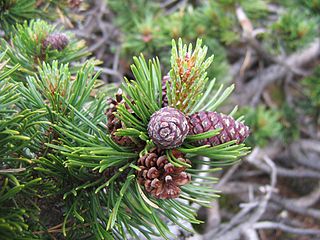
Pinus mugo, known as bog pine, creeping pine, dwarf mountain pine, mugo pine, mountain pine, scrub mountain pine, or Swiss mountain pine, is a species of conifer, native to high elevation habitats from southwestern to Central Europe and Southeast Europe.

Stachys is one of the largest genera in the flowering plant family Lamiaceae. Estimates of the number of species in the genus vary from about 300, to about 450. The type species for the genus is Stachys sylvatica. Stachys is in the subfamily Lamioideae. Generic limits and relationships in this subfamily are poorly known.
Natural Resources Conservation Service (NRCS), formerly known as the Soil Conservation Service (SCS), is an agency of the United States Department of Agriculture (USDA) that provides technical assistance to farmers and other private landowners and managers.
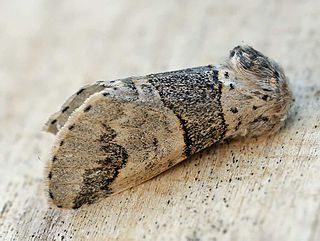
The poplar kitten is a species of moth in the family Notodontidae. The species was first described by Nikolaus Joseph Brahm in 1787. They are found throughout Europe and in North Africa, Mongolia, Kazakhstan and Xinjiang.
Hibiscadelphus woodii, or "Wood's hau kuahiwi", is a species of flowering plant in the family Malvaceae, endemic to Kauai, Hawaii. It is a small tree, reaching a height of 2.5–5 m (8.2–16.4 ft).
Psychotria hobdyi, the milolii kopiwai, Hobdy's wild-coffee or kopiko, is a species of plant in the family Rubiaceae. It is endemic to the Hawaiian Islands, where it is known only from the island of Kauai. There are about 10 populations for a total of about 120 individuals. It is threatened by habitat loss and was federally listed as an endangered species of the United States in 2010.
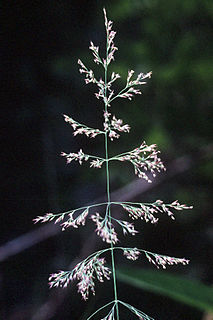
Calamagrostis canadensis is a species of grass, having three or more varieties, in the family Poaceae. It is known variously by the common names of bluejoint, bluejoint reedgrass, marsh reedgrass, Canadian reedgrass, meadow pinegrass, and marsh pinegrass.
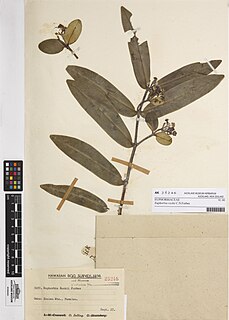
Euphorbia rockii is a rare species of flowering plant in the euphorb family known by the common names Koolau Range sandmat and Rock's broomspurge. It is endemic to Oʻahu, Hawaii, where it is known only from the Koʻolau Mountains. There are 200 to 300 plants remaining. Like other Hawaiian euphorbs, this plant is known locally as ʻakoko.
Cyanea procera is a rare species of flowering plant in the bellflower family known by the common name Molokai cyanea. It is endemic to Hawaii, where it is known only from the island of Molokaʻi. It is a federally listed endangered species of the United States. Like other Cyanea it is known as haha in Hawaiian.

Cyanea truncata is a rare species of flowering plant in the bellflower family known by the common name Punaluu cyanea. It is endemic to the islands of Oahu and Molokai in Hawaii, but it is now critically endangered. It exists in cultivation and some individuals have been planted in appropriate habitat. It is a federally listed endangered species of the United States. Like other Cyanea it is known as haha in Hawaiian.
Cyanea rivularis is a rare species of flowering plant in the bellflower family known by the common name plateau cyanea. It is endemic to Hawaii, where it is known only from the island of Kauaʻi. There are three small populations of the plant remaining in the wild, for a total of 19 individual plants. The plant was federally listed as an endangered species of the United States in 1996.

Kadua st-johnii is a rare species of flowering plant in the coffee family known by the common name Nā Pali beach starviolet. It is endemic to Hawaii, where it is known only from the Nā Pali coast of Kauai. It is a federally listed endangered species of the United States.

Hypericum cumulicola is a rare species of flowering plant in the family Hypericaceae known by the common name highlands scrub hypericum, or highlands scrub St. John's wort. It is endemic to Florida, where it is threatened by habitat loss and degradation. It is a federally listed endangered species of the United States.
Melicope rostrata, synonym Platydesma rostrata, is a rare species of flowering plant in the citrus family, known by the common name pilo kea lau li'i. It is endemic to Hawaii, where there are only about 100 individuals remaining on island of Kauai. It was federally listed as an endangered species of the United States in 2010.
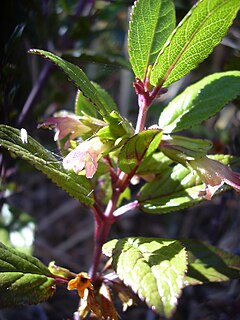
Stenogyne is a genus of flowering plants in the mint family first described in 1830. The entire genus is endemic to Hawaii.
- Stenogyne strangulationA.Gray - narrow leaf stenography
- Stenogyne bifidaHillebr. - two cleft stenography - Molokai
- Stenogyne methodicalnessA.Gray - bog stenography - Big Island
- Stenogyne cosmicallySherff - Maui
- Stenogyne campanulataWeller & Sakai - Kala Valley stenography - Kauai
- †Stenogyne incinerateHillebr - Maui but extinct
- Stenogyne cranwelliaeSherff - Big Island
- †Stenogyne haliakalaeWawra - Maui but extinct
- Stenogyne kaalaeWawra - Oahu
- Stenogyne kamehamehaeWawra - Molokai, Maui
- Stenogyne kanehoanaO.Deg. & Sherff - Oahu stenography - Oahu
- Stenogyne kauaulaensisK.R.Wood & H.Oppenh. - Maui
- Stenogyne kealiaeWawra - Kauai
- Stenogyne macranthaBenth. - Big Island
- Stenogyne microphyllaBenth. - Maui, Big Island
- †Stenogyne oxygonaO.Deg. & Sherff - Big Island but extinct
- Stenogyne purpureaH.Mann - Kauai
- Stenogyne rotundifoliaA.Gray - pua'ainaka - Maui
- Stenogyne rugosaBenth. - ma'ohi'ohi - Maui, Big Island
- Stenogyne scrophularioidesBenth. - mohihi - Big Island
- Stenogyne sessilisBenth. - Lanai, Maui, Big Island
- †Stenogyne viridisHillebr. - Maui but extinct

Stenogyne kanehoana is a rare species of flowering plant in the mint family known by the common name Oahu stenogyne. It is endemic to Hawaii, where it is known only from the Waianae Range on the island of Oahu. It is a federally listed endangered species of the United States.
Stenogyne kealiae is a rare species of flowering plant in the mint family known by the common name Keal's stenogyne. It is endemic to Hawaii, where it is known only from the island of Kauai. It was federally listed as an endangered species of the United States in 2010.
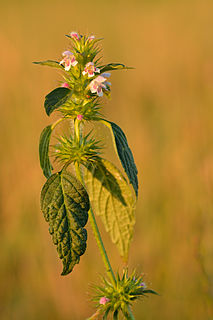
Galeopsis, commonly called hemp-nettle or hempnettle, is a genus of annual herbaceous plants native to Europe and Asia. Some species are naturalized in North America and New Zealand.

Polyscias flynnii is a plant species endemic to the island of Kauai in Hawaii. It is rare, found only in one population covering about 1 km2 in the Kalalau Valley. It is regarded as threatened. It is threatened by feral goats and non-native plant species in its habitat. It was federally listed as an endangered species of the United States in 2010.
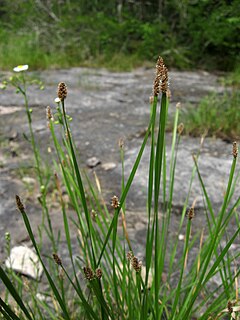
Eleocharis bifida is a species of spikesedge known by the common name glade spikerush. It is native to the Eastern United States, where it is endemic to the Interior Low Plateau and very small part of the Ridge and Valley ecoregions. This is mostly in Kentucky and Tennessee, extending into southern Indiana, northern Alabama, and northwestern Georgia. It is found only in wet areas in cedar glades, such as pools and streamsides. This narrow habitat requirement is the reason for it being considered vulnerable.













